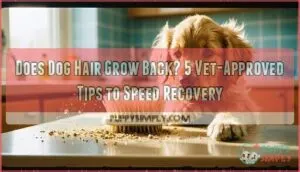This site is supported by our readers. We may earn a commission, at no cost to you, if you purchase through links.
 Yes, dog hair does grow back in most cases, though the timeline varies by breed and circumstance.
Yes, dog hair does grow back in most cases, though the timeline varies by breed and circumstance.
You’ll typically see new growth within 2-6 weeks, with full restoration taking 3-6 months.
However, double-coated breeds like Huskies may experience permanent texture changes if shaved too close.
The reason for hair loss matters too – whether it’s from grooming, injury, or medical conditions affects regrowth quality.
Your pup’s age, health, and genetics play vital roles in this natural process.
While patience is key, there are proven methods to encourage faster, healthier regrowth that can make all the difference.
Table Of Contents
- Key Takeaways
- Promoting Fur Growth After a Cut
- Ways to Care for Your Pet’s Scratch or Scrape
- Hair Growth Stages in Dogs
- How to Speed Up Dog Hair Growth
- Keeping Your Pet and Their Fur Healthy Post-Cut or Vet Visit
- Frequently Asked Questions (FAQs)
- Does dog hair grow back?
- Does dog hair grow back after shaving?
- How long does hair regrowth last on a dog?
- Does age affect dog hair growth?
- Will my dog’s hair grow back after clipping?
- How long does it take a dog to grow hair?
- How long does it take for a dog’s hair to grow back?
- Does dog fur grow back after a cut?
- Will a dog’s hair grow back the same if you shave it?
- Will a dog’s bald spot grow back?
- Conclusion
Key Takeaways
- Your dog’s hair will grow back naturally – You’ll typically see new growth within 2-6 weeks, with full restoration taking 3-6 months, though double-coated breeds may experience permanent texture changes if shaved too close.
- You can speed up regrowth with proper care – Feed your dog a balanced diet with at least 18% protein, add fish oil supplements for omega-3 fatty acids, and maintain regular grooming to stimulate blood circulation to the hair follicles.
- Wound care is crucial for healthy regrowth – Clean any cuts or scrapes twice daily with a saline solution, prevent your dog from licking the area with an Elizabethan collar, and watch for signs of infection like swelling or discharge.
- Your dog’s age and breed affect recovery time – Senior dogs experience slower regrowth due to decreased cell regeneration, while single-coated breeds typically recover faster than double-coated ones that require specialized care.
Promoting Fur Growth After a Cut
When your dog’s hair has been cut or shaved, you’ll want to support healthy regrowth while protecting the exposed skin.
Proper care during this vulnerable period guarantees your dog’s coat returns to its normal thickness and appearance within the expected timeframe.
Proper Wound Care
Proper wound care forms the foundation of successful dog hair regrowth after cuts or injuries. Clean the affected area gently with veterinarian-approved solutions to remove debris and bacteria. Apply prescribed topical treatments to support the dog hair regrowth process and minimize scarring.
Clean wounds heal faster and set the stage for beautiful, healthy coat regrowth in your beloved companion.
Monitor the wound daily for signs of healing progress, noting any changes in color, swelling, or discharge. You may need to purchase dog wound cleaner for ideal care.
Follow these essential wound care steps:
- Keep wounds clean and dry – Use sterile saline solution or vet-recommended cleaners twice daily, avoiding harsh chemicals that disrupt dog hair growth factors and delay the natural dog hair regrowth timeline.
Preventing Infection
Wound cleaning becomes your first line of defense against bacterial infection that can derail dog hair regrowth. Clean the area gently with saline solution twice daily, removing debris that harbors harmful bacteria.
Your vet may recommend antibiotic use for deeper cuts or signs of skin infection.
| Prevention Method | Frequency | Purpose |
|---|---|---|
| Wound cleaning | 2x daily | Remove bacteria/debris |
| Barrier methods | As needed | Protect from contamination |
| Environmental hygiene | Daily | Reduce infection sources |
| Immune support | Ongoing | Strengthen natural defenses |
Barrier methods like sterile gauze protect vulnerable areas from dirt and moisture.
Environmental hygiene matters too—keep your dog’s bedding clean and vacuum regularly.
Watch for increased itching or skin irritation, which signals potential problems requiring immediate veterinary attention.
Avoiding Licking or Biting at The Wound
Dogs naturally want to lick wounds, but this habit slows dog hair growth and creates bald spots.
Dogs instinctively lick their wounds, but this natural behavior actually hinders healing and can create permanent bare patches in their coat.
Elizabethan collars provide essential wound protection by preventing access to the area. Many owners find effective collar options available online.
Bitter sprays deter dog licking and biting behaviors effectively. Consider bandaging safely for extra protection, while distraction techniques like puzzle toys redirect your pet’s attention from the healing site, which is a critical step in the healing process.
Regular Check-ups With The Vet
Schedule veterinarian appointments every few months to monitor your dog’s healing progress and catch potential complications early.
Early detection of skin conditions or breed predispositions can prevent costly treatments down the road. Remember that annual wellness checks are also essential for early detection of health changes.
- Health monitoring: Track hair regrowth patterns and skin condition changes
- Preventative care: Address underlying issues before they worsen dog hair loss
- Cost considerations: Regular check-ups prevent expensive emergency treatments later
Ways to Care for Your Pet’s Scratch or Scrape
When your dog gets a scratch or scrape, quick action makes all the difference.
Start with gentle wound cleaning using warm water to remove debris. Apply proper bandaging techniques if the cut is deep, but allow shallow wounds to breathe.
Watch for infection signs like swelling, redness, or unusual discharge. Your veterinarian can recommend pain management options if your pet seems uncomfortable.
Clean wounds heal faster and promote better dog hair regrowth. Good dog skin care during recovery prevents complications that could delay hair growing back.
Remember, proper wound care today means healthier dog hair growth tomorrow, and it is crucial for dog hair regrowth and overall good dog skin care.
Hair Growth Stages in Dogs
Understanding your dog’s hair growth cycle helps you set realistic expectations for regrowth.
The anagen stage involves active hair growth lasting months to years, determining final coat length. During the catagen phase, follicles shrink and hair stops growing.
The telogen stage represents a resting period where hair remains attached but inactive. Finally, the exogen phase releases old hairs to make room for new growth.
This follicle cycling means not all hairs regrow simultaneously, explaining why complete coat restoration takes time. Regular dog grooming practices can also influence coat health and support overall dog care.
How to Speed Up Dog Hair Growth
While your dog’s hair will naturally regrow over time, you can take specific steps to support and accelerate the process.
Proper nutrition, regular grooming, and stress management create ideal conditions for healthy hair growth, helping your pet’s coat return to its full thickness more quickly, with healthy hair growth being the ultimate goal.
Balanced Diet and Nutrition
Proper nutrition acts as your dog’s foundation for healthy hair regrowth.
Essential nutrients like high-quality protein, omega-3 fatty acids, and vitamins A and E directly support follicle health and new strand development.
A balanced diet containing at least 18% protein helps rebuild damaged hair cells, while hydration importance can’t be overstated—water carries these essential nutrients throughout your pet’s system.
Consider breed-specific diets, as some dogs require specialized nutrition for ideal coat recovery.
Watch for food allergies that might slow healing, and discuss dietary supplements with your veterinarian.
Quality pet nutrition creates the perfect environment for dog hair growth and overall wellness.
Regular Grooming and Brushing
Beyond feeding your dog the right nutrients, consistent dog grooming plays a key role in speeding hair regrowth.
Regular brushing stimulates blood circulation to hair follicles, encouraging faster growth while removing dead skin cells that can block new hair development.
Your brushing frequency should match your dog’s coat type.
Short-haired breeds need weekly sessions, while long-haired dogs require daily attention for ideal shedding control.
A quality brush is key, so consider a dog grooming brush for best results.
Here’s what makes effective dog grooming for growth:
- Use appropriate grooming tools for your dog’s specific coat type
- Brush gently to avoid skin irritation during recovery
- Focus on areas where hair is regrowing slowly
- Consider professional grooming every 6-8 weeks
- Apply dog grooming techniques that promote circulation and support hair regrowth.
Massaging The Skin
Gentle skin massage works wonders for circulation improvement and follicle stimulation.
Your fingertips can activate oil glands while reducing inflammation around hair follicles.
This simple technique creates a bonding experience that supports dog hair growth throughout the natural dog hair cycle.
| Massage Technique | Benefits | Frequency |
|---|---|---|
| Circular motions | Boosts blood flow | Daily, 5 minutes |
| Light pressure | Stimulates follicles | Twice weekly |
| Warm hands | Reduces inflammation | During grooming |
| Gentle strokes | Activates oil glands | Before baths |
| Full-body massage | Promotes dog coat regrowth | Weekly sessions |
Using Fish Oil Supplements
Fish oil supplements can substantially promote dog hair growth by delivering essential omega-3 fatty acids that strengthen your pet’s coat from within.
These dog nutrition powerhouses offer visible results through improved thickness and reduced shedding. However, dosage guidelines matter—consult your veterinarian to determine appropriate amounts based on your dog’s size.
Quality health supplements prevent potential risks like vitamin E depletion, ensuring omega-3 benefits support maximum recovery without complications.
Fish oil is rich in EPA and DHA, which are key omega-3 fatty acids.
Avoiding Stress and Anxiety
Stress and anxiety can slow your dog’s hair regrowth substantially.
Create a calm environment where your pup feels secure, establishing a safe retreat space away from household chaos.
Consider pheromone treatments or herbal remedies to ease dog anxiety naturally.
If dog stress persists despite your efforts, a behaviorist consult might be necessary to help restore their natural confidence and promotes healthy fur recovery, remembering that dogs use their coat for emotional expression.
Keeping Your Pet and Their Fur Healthy Post-Cut or Vet Visit
Why does post-cut care matter so much for your furry friend? Proper attention during recovery guarantees healthy dog hair growth and prevents complications that could delay your dog’s regrowth timeline.
Here are three essential steps for ideal post-visit care:
- Monitor wound healing – Watch for excessive redness, swelling, or discharge that signals infection
- Maintain gentle grooming practices – Use fragrance-free shampoos and avoid harsh brushing near sensitive areas
- Support hair growth stages – Add fish oil supplements to boost Post-Cut Nutrition and promote faster dog hair growing back
Consistent Vet Communication and Preventative Measures accelerate recovery. Regular checkups help with early detection of issues.
Frequently Asked Questions (FAQs)
Does dog hair grow back?
Yes, your dog’s hair will grow back after shaving or loss. Most dogs see regrowth within two to three months, though double-coated breeds may experience permanent damage from improper shaving.
Does dog hair grow back after shaving?
Like a phoenix rising from ashes, your dog’s coat will return after shaving.
Hair typically regrows within two to three months, though double-coated breeds may experience permanent damage to their natural insulation system.
How long does hair regrowth last on a dog?
Hair regrowth typically takes two to three months for your dog’s coat to return to normal length.
However, this timeline varies substantially based on your dog’s breed, age, health status, and whether they’ve single or double coats, which can significantly impact the regrowth process.
Does age affect dog hair growth?
Like autumn leaves that grow slower on older trees, your aging pup’s coat won’t bounce back as quickly.
Senior dogs experience slower hair regrowth due to decreased cell regeneration, reduced metabolism, and potential health issues affecting their natural growth cycles.
Will my dog’s hair grow back after clipping?
Your dog’s clipped hair will grow back, typically within two to three months.
Single-coated breeds regrow faster than double-coated ones.
Proper nutrition and health support ideal regrowth rates for your pet’s coat.
How long does it take a dog to grow hair?
Rome wasn’t built in a day, and your dog’s coat won’t return overnight either.
Typically, you’ll see hair regrowth within four to six weeks, with full restoration taking two to three months depending on breed.
How long does it take for a dog’s hair to grow back?
Your dog’s hair typically grows back within two to three months after shaving or loss.
However, this timeline varies based on your pet’s breed, age, health, and whether they’ve single or double coats.
Does dog fur grow back after a cut?
Studies show hair regrowth typically takes 13-15 weeks for most breeds.
Yes, your dog’s fur will grow back after cutting, though double-coated breeds may experience permanent texture changes if shaved too short.
Will a dog’s hair grow back the same if you shave it?
Yes, your dog’s hair will grow back after shaving, but it mightn’t look exactly the same. Double-coated breeds may experience permanent texture changes, while single-coated dogs typically regrow normal hair.
Will a dog’s bald spot grow back?
Most bald spots will grow back within two to three months, but it depends on what’s causing the hair loss.
If it’s from illness, allergies, or infections, you’ll need to treat the underlying condition first.
Conclusion
Transforming your dog’s patchy, bare skin into a magnificent coat of fur isn’t just wishful thinking—it’s absolutely achievable.
Remember, does dog hair grow back depends largely on your dedication to proper care.
By implementing these vet-approved strategies, you’re setting your furry friend up for successful regrowth.
Consistent nutrition, gentle grooming, and patience will restore their natural beauty.
Your dog’s coat will thank you, and you’ll both feel confident knowing you’ve provided the best possible recovery support.
- https://pubmed.ncbi.nlm.nih.gov/14989702/
- https://pangovet.com/?utm_source=dogster&utm_medium=article&utm_campaign=dogster_general
- https://www.merckvetmanual.com/dog-owners/skin-disorders-of-dogs/hair-loss-alopecia-in-dogs
- https://dogdorable.com/how-long-does-it-take-for-dogs-hair-to-grow/
- https://www.webmd.com/skin-problems-and-treatments/hair-loss/science-hair








